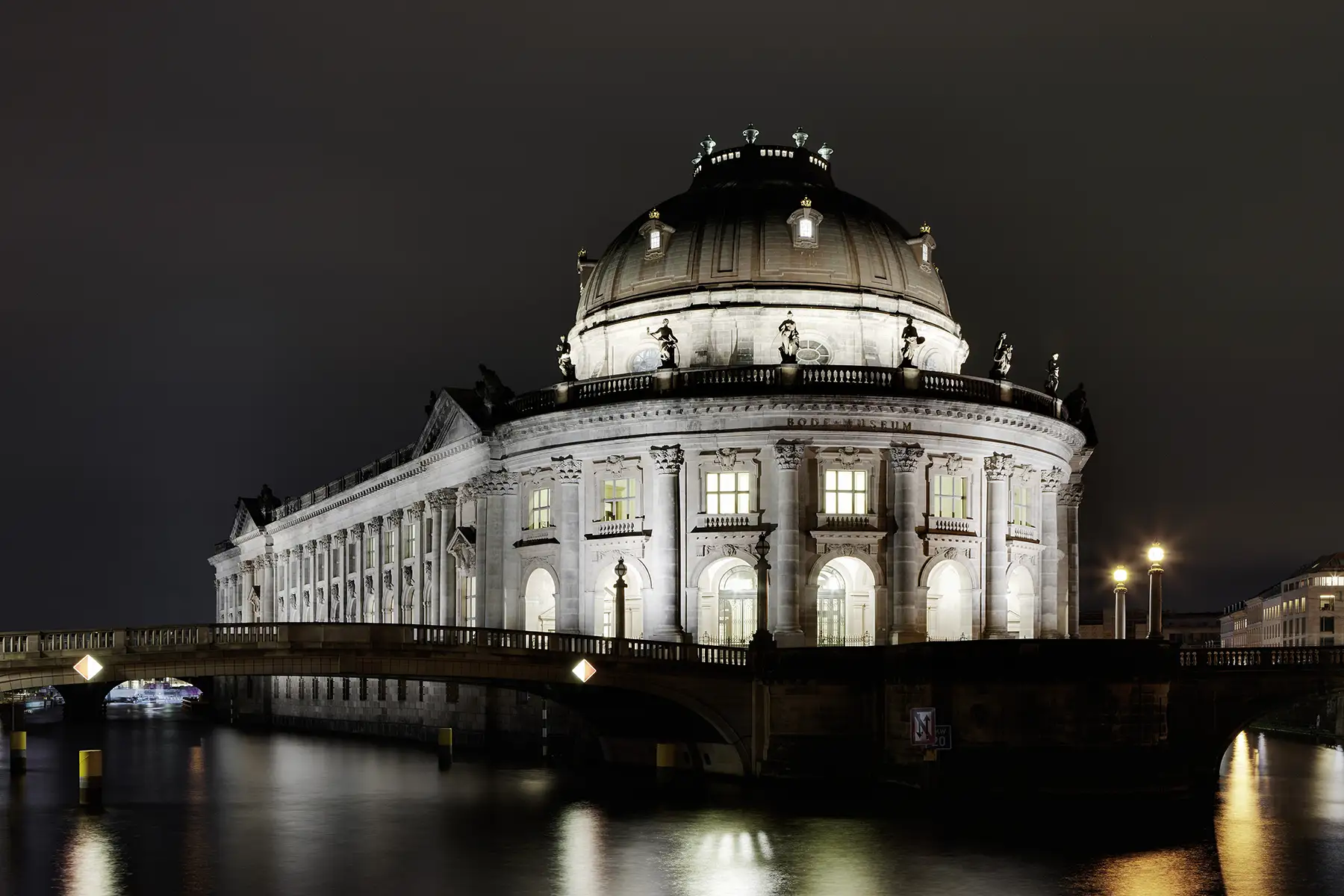
Museum Island Berlin – part project Bode Museum (BMU)
Berlin
Distinction:
Deutscher Lichtdesignpreis 2013 – Special appreciation by the jury
The Bode Museum opened in 1904 and is located on the northern tip of Museum Island in the centre of Berlin. Its façade runs directly along the banks of the Spree, giving it the appearance of a moated castle.
The lighting is in neutral white light colour with high colour rendering quality to counteract neutralisation of the colour nuances of the stone facades at night. As this is most similar to moonlight, the light looks as natural as possible. Accentuations are made with warm light colour, e.g. the figures above the entrance portal and the two domes.
To convey a cohesive overall image in the ensemble of buildings on Museum Island, it is crucial that the beam angles are matched to the geometry of the architecture, as in the other part projects. Thus, the light fields cover the entire façade from the top edge of the plinth up to the roof cornices.
The façade of adjacent buildings and bridges is illuminated in order to be able to largely dispense with pole luminaires. Poles are arranged only in exceptional cases, such as on the Spree side in Monbijou Park and at Kupfergraben, because there are no buildings.
Another important requirement for the lighting was to prevent light pollution, that is, not to emit any erroneous radiation (often incorrectly referred to as scattered radiation) into the urban environment. Due to the proximity to the light rail viaduct, it had to be ensured that train drivers were not blinded and that signalling systems were not affected. Blinding the captains by the lights mounted on the Monbijou Bridge also had to be prevented.
Using standard luminaires was out of the question due to the specific radiation properties and the high design demands. All systems were designed by Conceptlicht and the reflectors were developed.
Architects:
Büro Prof. Heinz Tesar ABT, Levin Monsigny Landschaftsarchitekten
Photograph:
Marcus Bredt
Category: Outdoor lighting




Museum Island Berlin – part project Bode Museum (BMU)
Berlin
Distinction:
Deutscher Lichtdesignpreis 2013 – Special appreciation by the jury
The Bode Museum opened in 1904 and is located on the northern tip of Museum Island in the centre of Berlin. Its façade runs directly along the banks of the Spree, giving it the appearance of a moated castle.
The lighting is in neutral white light colour with high colour rendering quality to counteract neutralisation of the colour nuances of the stone facades at night. As this is most similar to moonlight, the light looks as natural as possible. Accentuations are made with warm light colour, e.g. the figures above the entrance portal and the two domes.
To convey a cohesive overall image in the ensemble of buildings on Museum Island, it is crucial that the beam angles are matched to the geometry of the architecture, as in the other part projects. Thus, the light fields cover the entire façade from the top edge of the plinth up to the roof cornices.
The façade of adjacent buildings and bridges is illuminated in order to be able to largely dispense with pole luminaires. Poles are arranged only in exceptional cases, such as on the Spree side in Monbijou Park and at Kupfergraben, because there are no buildings.
Another important requirement for the lighting was to prevent light pollution, that is, not to emit any erroneous radiation (often incorrectly referred to as scattered radiation) into the urban environment. Due to the proximity to the light rail viaduct, it had to be ensured that train drivers were not blinded and that signalling systems were not affected. Blinding the captains by the lights mounted on the Monbijou Bridge also had to be prevented.
Using standard luminaires was out of the question due to the specific radiation properties and the high design demands. All systems were designed by Conceptlicht and the reflectors were developed.
Architects:
Büro Prof. Heinz Tesar ABT, Levin Monsigny Landschaftsarchitekten
Photograph:
Marcus Bredt
Category: Outdoor lighting